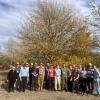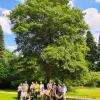Editor's Picks
Plant Focus
Published May 2014 in International Oaks No. 25: 13–22
Abstract
Quercus ithaburensis subsp. macrolepis (Kotschy) Hedge & Yalt. is a semi-deciduous native of the Mediterranean region that produces acorns 4-6 cm/1.5-2.3 long, weighing 10-40 g/.35-1.4 oz each and with very large caps that have long, protruding scales. Q. ithaburensis subsp. macrolepis has been known by many aliases, the most common being Q. aegilops L. or Q. aegilops subsp. macrolepis (Kotschy) A. Camus as well as Valonia oak. The island of Kea is located in the drought prone Southern Cyclades where annual rainfall rarely exceeds 300 mm/12 in. Today, rugged Valonia oak cover 2,000 hectares/5,000 acres of central and eastern Kea, representing nearly 8% of the entire oak population in Greece. Although the forest is protected under the Natura 2000 protocol, trees continue to be sacrificed for firewood. Historically, the exportation of acorn caps for the leather tanning industry was a major sector of the local agricultural economy for at least four hundred years. The Hamada Acorn Initiative for Kea works to develop and promote responsibly sourced, oak-based income for farm families by facilitating the exportation of acorn caps to traditional leather tanneries and by developing and promoting acorn-based products.
Keywords
Quercus ithaburensis subsp. macrolepis, Q. aegilops, Valonia oak, hamada, tanning industry
References
1. Eleni Yiannakopoulou. “Exportations from Oak on Kea” (paper read by Stephanos Lepouras at, Oak: tree physiognomy and what it offers to the island of Kea, Kea, 8-9 October, 2005).
2. Bernard Randolph, The Present State of the Islands in the Archipelago (Oxford, 1687).
3. Joseph Pitton de Tournefort, Relation d’un voyage au Levant (Amsterdam: La Compagnie, 1718), 334.
4. Eleni Yiannakopoulou, “Oak Forest, Past, Present & Future (presentation, Xiromero, Messologi, Greece, May 17, 2002).
5. Eleni Yiannakopoulou, “Oak Forest, Past, Present & Future” (presentation, Xiromero, Messologi, Greece, May 17, 2002).
6. Thodoros Veltitsas, “Oak Forest, Past, Present & Future” (introduction, Xiromero, Messologi, Greece, May 17, 2002).
7. John D. Vyza, The Acorn and Its Importance for the National Economy (Athens, 1940).
8. Eleni Yiannakopoulou, “Exportations from Oak on Kea” (paper read by Stephanos Lepouras at, Oak: tree physiognomy and what it offers to the island of Kea, Kea, 8-9 October, 2005).
9. Suzanne Amigues, Theophraste—Recherches sur les plantes—A l’origine de la botanique (Paris: Belin, 2002), 80.
10. C. Hart Merriam, Acorn, A Possibly Overlooked Source of Food, National Geographic, 1920. 34: 129-137.
11. Guide for Acorn Use in Native California, a Mobile Classroom Outreach Trunk. Anthropology Museum, California State University, Sacramento: www.csus.edu/anth/museum
12. John Russell Smith, Tree Crops: A Permanent Agriculture (New York: Harcourt Brace, 1929).
13. John Russell Smith. Tree Crops, 154.
14. Dimitrios Kavadas, Illustrated Botanical—Phytological Dictionary. Book A (Athens, 1956).
15. TEDxThessaloniki at http://www.youtube.com/watch?v=2drjwGW8Ess
16. Ian Pearse and Walt Kroenig, Acorns, Acorns Everywhere But Not In Every Year, International Oaks (24): 117-121.
17. Dimitrios Kavadas. Illustrated Botanical, 1340.
18. Dimitrios Kavadas, Illustrated Botanical, 1343.
19. X. Diapoulis, in The Acorn and it’s Importance for the National Economy, John D. Vyza (Athens, 1940) and in Illustrated Botanical—Phytological Dictionary. Book A, Dimitrios Kavadas (Athens, 1956).
20. Dimitrios Kavadas, Illustrated Botanical, 1343.
21. John D. Vyza, The Acorn, 9.
22. John D. Vyza, The Acorn, 11.















